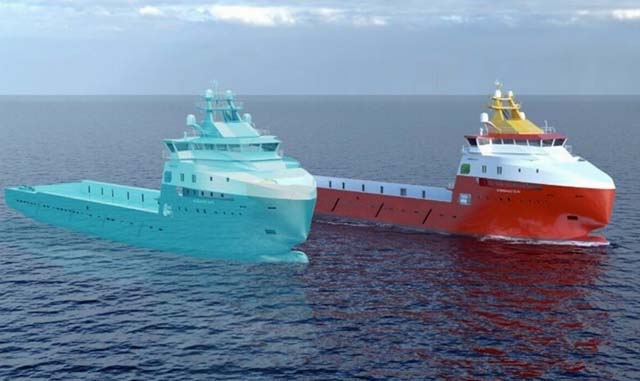Through a project known as Piezo, after three years of R&D, Vard has developed a concept design for a PSV using batteries as the primary energy source together with offshore charging.
One of the great challenges facing the petroleum and maritime industries today is climate change. Vard, alongside project partners Equinor, Sintef, the Research Council of Norway, Corvus Energy and Solstad Offshore, has investigated the feasibility of plug-in electric vessels sailing emission free in the North Sea, with charging facilities offshore and onshore.
The Piezo Project has:
- Identified energy consumption models, from on-board measurements by application of big data methods
- Developed a digital simulation twin for a plug-in electric PSV design
- Identified promising solutions to the technical challenges of re-charging ships offshore, which are now being realised as part of the Ocean Charger project
With cooperation from Solstad Offshore, Vard has collected high quality in-service data, forming the basis of the research.
Henrik Burvang, Research and Innovation manager Vard Design said: “We saw a great need to develop precise digital simulations of energy systems, and a great potential within electrification and utilisation of large battery packages in the offshore market. With Piezo, we got a useful arena to research both these development aspects in parallel.”
The research has taken place at Vard Design, Vard Electro, with assistance from Sintef Ålesund. Sintef conducts independent research within digitalisation, virtual prototyping and simulation, and machine learning, with special focus within maritime, fisheries, and aquaculture. The result of the collaboration within the project is a digital simulation twin that behaves identically to Solstad’s PSV.
Burvang said: “Vard Design has developed digital simulation modelling tools, which have now been verified by collected data over two years. Furthermore, we have developed a new model based on battery-electric propulsion and a brand-new PSV design. Using as little energy as possible is crucial for zero-emission ships. With simulations like this, we will be able to get a full overview of the energy flow in the ship before building it, and that is one of the reasons why this simulation model is a potentially powerful tool for future projects.”
Corvus Norway is leading the adaptation of hybrid-electric propulsion technology. Several ground-breaking electric and hybrid projects for the marine industry are powered by Corvus Energy battery systems. Corvus has supported the project with models to ensure accurate simulation in dimensioning of battery packs, life cycle analysis and battery arrangements.
Burvang continued: “We see that the concept of battery-electric PSVs is feasible and when we now also realize offshore charging through our innovation Ocean Charger, this will be very attractive for the offshore and renewables market. The research project Piezo has laid the foundation for our new all-electric concepts.”
The Vard Group, of which Vard Design and Vard Electro are part, has built the equivalent of 35% of the 160 PSVs in Norway’s active fleet. Around 50 PSVs in today’s fleet are over 15 years old and will need renewal to meet new environmental demands. Conservative estimates indicate there is the potential for at least 10 new plug-in electric PSVs in Norway alone by 2030.
Burvang said: “Solstad Offshore and Equinor have a great interest in the electric PSV concept and the infrastructure of charging offshore and have been important contributors when it comes to the operational perspective. They spar with us on the concept and solutions and give us feedback on what is realistic.”
Thomas Olsvik, VP Conceptual Design, Vard Design, said: “There is a long process behind what will now be a zero-emission ship. Even before we started looking at fuel, we had been working for several years on the next generation PSV concept. This includes major improvements in propulsion and hull resistance. Because regardless of the fuel, it’s about reducing energy consumption for the mission the boat will do.”
Hull optimisation is an important part of this work. Therefore, Vard has developed a tool that ensures greater understanding among both the customer and others involved.
Thomas Brathaug, Vard Design Principal Naval Architect Conceptual Design said: “The tool makes it possible to optimise the hull design early in the project. Thus, the hull design can be optimised for the operation the customer will perform. This means that we can sit down with the customer and show how the choices they make will affect their energy consumption.”
However, hull optimisation alone is not enough. All design disciplines at VARD have a great responsibility to reduce energy consumption.
Olsvik said: “The hull development has become very good, but there are several other things we need to look at – both we at Vard and those who will use the ship. Many PSVs are too big, and we have a lot of improvement to do when it comes to, for example, interior design, operation, and other support systems. In the future, I think we will see more specialised PSVs.
Interdisciplinary collaboration between Concept Design and Research and Innovation is essential to ensure that Vard looks further ahead than the individual projects. In answer to the question of when we can expect to see an all-electric PSV in operation, Olsvik is cautious, but if things go according to plan, it may not take any more than three years.
Olsvik said: “The technology is there. Now it’s just a matter of finding the balance in terms of finances, range, and so on. In theory, we could see an all-electric PSV in operation earlier, but it must work out for both tenant and shipowner. Either way, we at Vard are ready.”



